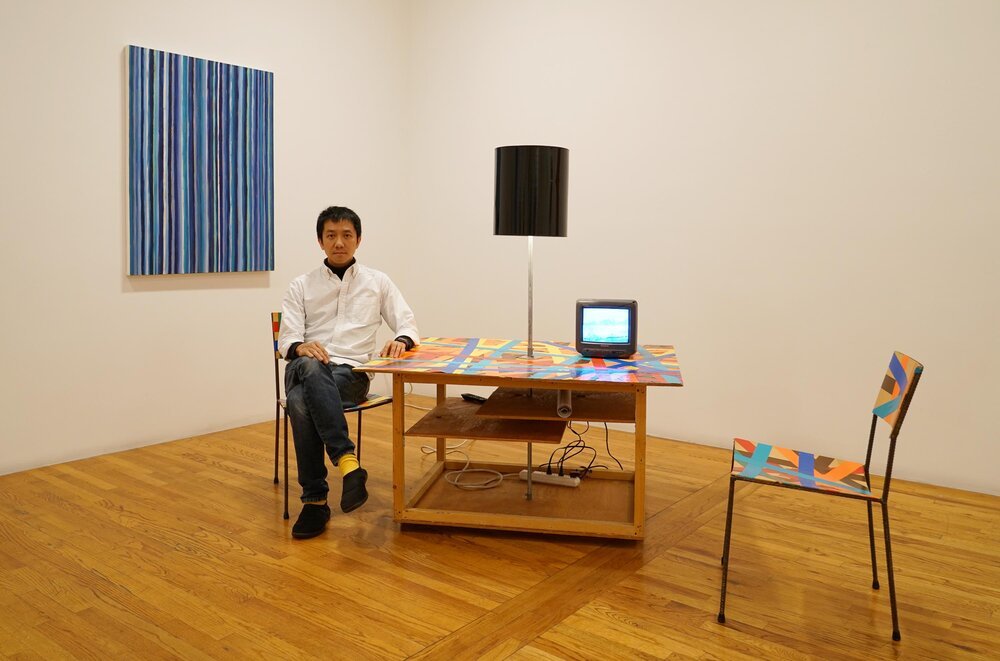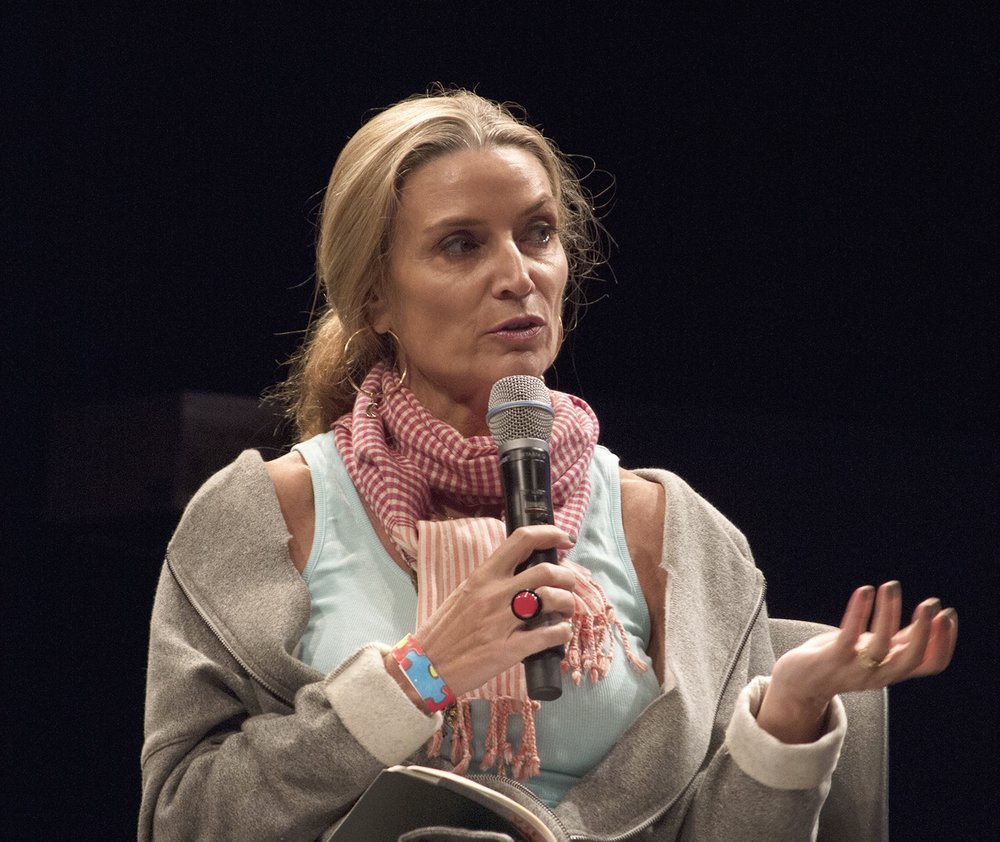Conversation with Angkrit Ajchariyasophon
Painter, curator and gallerist at ARTIST+RUN
By Ian Tee
Angkrit Ajchariyasophon sitting on Franz West's 'Creativity: Furniture Reversal'. Angkrit’s painting hangs on the wall to his right, in the exhibition 'The Thick Lines Between Here and There' at Owen James Gallery, New York. Image courtesy of the artist.
For more than a decade, Angkrit Ajchariyasophon (b. 1976) has been wearing the hats of artist, curator and gallerist. The Thai artist spent his formative student years at Chiang Mai University in the late 1990s, a decade defined by Mit Jai Inn's Chiang Mai Social Installation project which established the city as an art centre alongside Bangkok. This environment had a profound impact on Angkrit's outlook on art and its relationship with social space. In addition to the regular exhibitions at Angkrit Gallery in Chiang Rai (2008-2016) and ARTIST+RUN in Bangkok, his key curatorial projects have included the 2013 Singapore Biennale 'If the World Changed' and 'Chiang Mai Now!' (2011). While Angkrit has made works that straddle various styles, he is best known for his non-objective abstract paintings.
We speak to Angkrit about his experience establishing independent galleries in Thailand, his curatorial interests and how he manages these roles in addition to a studio practice.
Angkrit with 'Yellow Project (frog in the coconut shell)' (1999) during his student days at Chiang Mai University's Faculty of Fine Arts. Image courtesy of the artist.
You have spoken about learning from the late Thawan Duchanee and his help in preparing you for the university entrance exam. I'd like to begin this interview with a question about your time studying in Chiang Mai University. What was the atmosphere like in the late 1990s? And who were the artists who influenced you?
I studied at Chiang Mai University from 1995 to 2000. The Chiang Mai Social Installation project had already started and I had the chance to be a volunteer for one of its founders, Prof. Uthit Atimana, when he established the Saturday Group in 1995. I studied with Kamin Lertchaiprasert and also helped out during the early period of 'The Land' project. Prof. Somkiet Tongnamo taught Art Philosophy and Art Criticism, and he was the founder of 'Midnight University', which was an important online academic forum. I was also an assistant to the French artist Anne Rochette, giving her motorcycle rides around Chiang Mai.
All these artists and professors had a big influence on me and my later works.
Uten Mahamid, 'Small and Strange', 2008, exhibition installation view at Angkrit Gallery, Chiang Rai. Image courtesy of the artist and Angkrit Ajchariyasophon.
You opened Angkrit Gallery in 2008, the only alternative art space in Chiang Rai at the time. Aside from supporting exhibitions by local artists, it also hosted performances, concerts and film screenings. Could you talk about the venue and how the gallery was sustained?
Angkrit Gallery was situated on the second floor of my restaurant, where I worked as the manager since graduating from university. I am the second generation of this family business and the gallery ran on revenue generated from it. Our inaugural exhibition was Uten Mahamid's solo 'Small and Strange' (2008).
Angkrit Gallery was non-profit space established to support independent artists. Artworks were seldom sold but when they were, I did not take any commission from the artists. The gallery and artists shared the costs of putting together the exhibition such as the installation, transportation and the opening reception expenses.
Pichet Klunchun Dance Company, 'The Intangibles of Emptiness', 2019, exhibition installation view at ARTIST+RUN, Bangkok. Image courtesy of the artists and ARTIST+RUN.
In 2016, you founded ARTIST+RUN in Bangkok. Could you share the reasons for this development? Did it have to do with being closer to art production in Bangkok or trying to reach a bigger audience or market?
Angkrit Gallery Chiang Rai was permanently closed after I moved to Bangkok. I established ARTIST+RUN as an experiment to reflect the change in location and today's environment. Its name emphasises the fact that the gallery is operated by an artist and I think about it like an art practice. However, the objective is to make ARTIST+RUN a commercial gallery. I believe Bangkok has a diversity of cultures and the space for testing out new possibilities of running a gallery.
One of the major exhibitions you curated was 'Chiang Mai Now!' (2011) at Bangkok Art and Culture Centre (BACC). Featuring works from 12 artists and cultural activists, it was a snapshot of the city's dynamic art and social scene. How did the opportunity come about and why was 2011 a good year to take stock of the Chiang Mai art scene?
Organisers from BACC thought the exhibitions in my gallery were interesting and I was invited to bring together the artworks by the artists from Angkrit Gallery for an exhibition there. However, my interest at that time had gone beyond the artistic and into cultural practices, especially activities organised by social groups.
Chiang Mai has a balance of the urban and the rural. Since the early 2000s, there have been so many changes in the city. There has been an increase in environmental groups, bicycle groups and artist-run spaces. The rise of such organisations shows the richness of contemporary cultures and how tradition mixes with modernity.
How has the Chiang Mai art scene changed since then?
I think Chiang Mai is always interesting. Many famous artists have moved to built their studios there. Rirkrit Tiravanija and Apichatpong Weerasethakul are two examples. I look forward to the new form of Chiang Mai Social Installation. I think Chiang Mai artists, especially the younger generations, should take a more active role in shaping public spaces.
'Angkrit Gallery Bangkok', 2018, exhibition installation view at Speedy Grandma, Bangkok. Image courtesy of Angkrit Ajchariyasophon.
I'd like to talk about your 2018 solo exhibition 'Angkrit Gallery Bangkok' at Speedy Grandma. As suggested by the title, you took over the art space and even replaced the original signboard. The exhibition featured 20 paintings, each by a different artist but none by you. It was both a conceptual gesture and a celebration of your work as a curator. Could you tell us what the exhibition meant to you?
‘Angkrit Gallery Bangkok’ was meant to "take over" Speedy Grandma, an artist-run space founded by Anchalee Lee Anantawat. I built a smaller plywood model of ARTIST+RUN gallery inside the space and invited 20 artist friends to show their small works here. There is no separation between my curatorial and artistic work. The idea was to create a platform that I could share with my artist friends. I think art will never exist without people, so my intention was to show the relationships around an art space.
Angkrit's studio in Bangkok. Image courtesy of the artist.
Even though your work as a gallerist and curator engage with a variety of practices, your studio practice is centred around painting. What does the medium of painting offer to you?
I appreciate painting and the time I work quietly in the studio. Being the manager of a restaurant with 200 seats in Chiang Rai and a gallerist in Bangkok, I have to meet with so many people. Painting is my serenity. It allows me to be focused and I am filled with energy when I paint.
Artists often have to wear many hats and juggle multiple jobs to sustain their art-making. How do you distribute your time between curatorial projects, running an art space and your own studio practice?
I do not sharply divide anything. I only do the work in front of me, focusing on the daily tasks rather than the future. I do my best in my own way. It is important to have enough time to rest and for my hobbies, like gardening.
Somluk Pantiboon at Jincheon Craft Museum, Jincheon, South Korea. Image courtesy of Angkrit Ajchariyasophon.
Most recently, you were in Jincheon, Korea, for a project with Chiang Rai-based artist and potter Somluk Pantiboon. Could you tell us more about his work and the exhibition in Jincheon?
Somluk Pantiboon is a potter and founder of Doy Din Dang Pottery in Chiang Rai. I met him when I was 18 years old. He is my teacher and a great mentor. Somluk received training in Japan and was inspired by the 'Mingei Movement’, a folk art movement developed in the late 1920s and 1930s in Japan. Its founder was Yanagi Sōetsu. Somluk and I were invited by Jincheon Art Village to show our works. It was a special time for me to follow this great artist and find Onggi traditional earthenware in Korea.
In a Bangkok101 article, you commented that while it was fantastic to have high-profile exhibitions such as the Bangkok Art Biennale, sustainability and momentum is necessary. You said, "We need more education, publications, media, and archiving for future research among students and curators. I am serious about how to bridge art and our livelihood." How do you think these goals can be achieved? Who are the stakeholders in the position to enact change?
In this developing country, it is everyone's job. We can start by doing our best work and doing it more seriously. I do not think the change will happen any time soon.
Thaiwijit Puengkasemsonboom, ‘Playground Up & Down’, 2018, acrylic, oil spray paint, metal collage on board, 122 x 99cm. Image courtesy of the artist and ARTIST+RUN.
Are there any upcoming exhibitions or projects you would like to share?
I have paintings on view in 'Day of the Dead' at WOOF PACK Bangkok and in the upcoming group exhibition 'Spectrosynthesis II' at BACC. The next show at ARTIST+RUN will feature new abstract paintings by Somyot Hananuntasuk. And in January 2020, Rikrit Tiravanija is curating a solo exhibition by Thaiwijit Puengkasemsomboon at the gallery.
'Day of the Dead' runs till 5 November 2019 at WOOF PACK Bangkok, while 'Spectrosynthesis II' is on view at BACC from 23 November 2019 to 1 March 2020.
Somyot Hananuntasuk's exhibition opens at ARTIST+RUN on 30 November 2019.



















